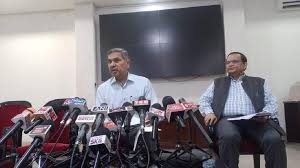Manipur’s Loktak Lake on the Brink: Rising Pollution Threatens Iconic Wetland
Loktak Lake, the largest freshwater lake in Northeast India and a Ramsar-designated wetland in Manipur, is under severe ecological stress due to worsening water pollution. A recent study by Eliza Khwairakpam (Nagaland University) shows that inflows from nine major rivers—carrying raw sewage, agricultural runoff, saline water intrusion, and heavy silt loads linked to shifting cultivation (jhum)—are degrading the lake’s water quality (parameters like dissolved oxygen, BOD, temperature).
The lake supports over 130 plant species and 400 animal species, and thousands of local livelihoods (fishermen, phumdi dwellers, tourism). If unchecked, the ecological collapse could threaten fisheries, tourism, hydropower, and local culture.
Recent research, particularly by Dr. Khwairakpam, points to worrying changes. Let’s unpack what the study found:
• Salinity increase: The lake is getting more saline because of inflow of saline water and raw sewage being drained in.
• Land‐use impact: The catchment of nine major rivers feeding Loktak (Khuga, Western, Nambul, Imphal, Kongba, Iril, Thoubal, Heirok, Sekmai) is heavily impacted by shifting cultivation (jhum) — nearly 42% of those basins.
• Water quality parameters degraded: Rivers such as Nambul and Khuga, which traverse more disturbed areas, showed poorer dissolved oxygen (DO), higher biological oxygen demand (BOD), higher temperatures, compared to rivers like Iril and Thoubal that flow through more forested regions. This highlights how vegetation and less disturbed land matter for water health.
• Biodiversity at risk: The lake hosts over 130 plant species and 400 animal species, and is listed in the Montreux Record (which lists wetlands at risk).
In simple terms: the lake is being “fed” by polluted, degraded rivers, and the lake itself is becoming an accumulation point for waste, silt, salts and ecological stress.
Sources of pollution & degradation
Understanding the “why” is essential if we want to address the problem. Here are key causes of Loktak’s crisis:
a) Agricultural expansion & shifting cultivation (jhum)
As parts of the catchment are cleared for cultivation, especially hill slopes doing jhum (slash‐and-burn) farming, soil erosion increases, silt load rises, and sediments enter the lake. The study notes a high percentage of jhum in many tributary basins.
b) Raw sewage and saline water intrusion
Urban waste, domestic sewage, and un-treated outflows are entering the inflowing rivers and hence the lake. Salinity increase is an indicator of that. The lake receives water that isn’t just fresh rain/runoff but altered by human discharges.
c) Land-use change and deforestation
Forested catchments buffer water quality (filtration, lower silt, stable hydrology). The better rivers (Iril, Thoubal) in the study were the ones flowing through more forest. This contrast underscores that deforestation and land degradation matter.
d) Hydropower infrastructure & barrages
The creation of the Ithai Barrage (for the Loktak Hydro Electric Project) alters hydrology, raises water levels, changes sedimentation patterns, affects the growth of phumdis, and has downstream ecological consequences.
e) Encroachments and aquatic weed proliferation
The phumdis and floating vegetation are increasingly disturbed; silt accumulation and sewage encourage weed growth, which further degrades water circulation and oxygen levels.
So – multiple stressors combine: land, water, climate, human waste, infrastructure.
Frequently Asked Questions
Q1: What major rivers feed Loktak Lake and how are they affecting its water quality?
Nine major rivers—Khuga, Western, Nambul, Imphal, Kongba, Iril, Thoubal, Heirok, Sekmai—feed the lake. The study found that rivers with high land-use disruption (agriculture/shifting cultivation) like Nambul and Khuga had worse water quality (low DO, high BOD) compared to more forested rivers like Iril and Thoubal.
Q2: Why is salinity rising in a freshwater lake like Loktak?
The lake is receiving inflows of saline water and raw sewage, drainage from human settlements and possibly altered hydrology that allows salt-water intrusion. These factors raise salinity, upsetting the freshwater ecosystem balance.
Q3: How are land-use changes like shifting cultivation (jhum) contributing to the problem?
Shifting cultivation involves clearing forest, burning and cultivating land that often lies on slopes or fragile terrain. The result is high soil erosion, large silt and sediment loads into rivers, which flow into Loktak, increasing turbidity, sedimentation, reducing water quality and harming aquatic life.
Q4: What are “phumdis” and why are they important for Loktak Lake?
Phumdis are floating mats of decomposed vegetation, soil and organic matter that float on Loktak Lake’s surface. They support vegetation, micro-habitats and are essential for the floating national park (Keibul Lamjao) where the endangered Sangai deer lives. Their degradation indicates ecosystem stress.
Q5: What immediate steps can local communities take to help restore the lake?
Communities can: engage in buffer-zone planting along catchment streams, practise soil conservation, reduce agrochemical runoff, prevent sewage entering rivers, participate in clean-up drives on lake edges, support sustainable tourism and fishing practices, and press local authorities for stronger enforcement of wetland protection laws.



